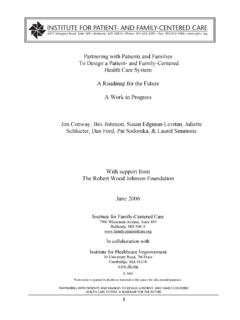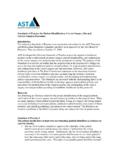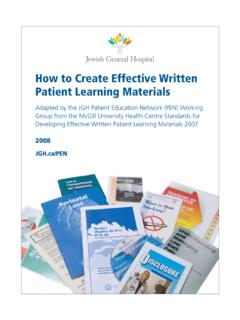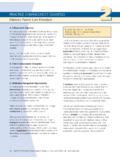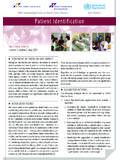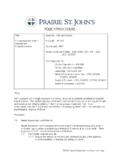Transcription of Topic 1: What is patient safety? - WHO | World …
1 80 Why is patient safety relevantto health care?There is now overwhelming evidence that significantnumbers of patients are harmed from their healthcare either resulting in permanent injury, increasedlength of stay (LOS) in hospitals and even death. Wehave learnt over the last decade that adverse eventsoccur not because bad people intentionally hurtpatients but rather that the system of health caretoday is so complex that the successful treatmentand outcome for each patient depends on a rangeof factors, not just the competence of an individualhealth-care provider. When so many people anddifferent types of health-care providers (doctors,nurses, pharmacists, social workers, dieticians andothers) are involved this makes it very difficult toensure safe care, unless the system of care isdesigned to facilitate timely and completeinformation and understanding by all the healthprofessionals. patient safety is an issue for all countries thatdeliver health services, whether they are privatelycommissioned or funded by the antibiotics without regard for thepatient s underlying condition and whetherantibiotics will help the patient , or administeringmultiple drugs without attention to the potential foradverse drug reactions, all have the potential forharm and patient injury.
2 patients are not onlyharmed by the misuse of technology, they canalso be harmed by poor communication betweendifferent health-care providers or delays inreceiving treatment. patient safety is a broad subject incorporating thelatest technology such as electronic prescribingand redesigning hospitals and services to washinghands correctly and being a team player. Many ofthe features of patient safety do not involvefinancial resources; rather, they involvecommitment of individuals to practise doctors and nurses can improve patientsafety by engaging with patients and their families,checking procedures, learning from errors andcommunicating effectively with the health-careteam. Such activities can also save costs becausethey minimize the harm caused to patients . Whenerrors are reported and analysed they can helpidentify the main contributing the factors that lead to errors isessential for thinking about changes that willprevent errors from being safety , system theory, blame, blameculture, system failures, person approach,violations and patient safety objectiveThe objective of this module is to understand the discipline of patient safety and its role in minimizing the incidence and impact of adverse events, and maximizes recovery from outcomes:knowledge and performance patient safety knowledge and skills covers manyareas: medication safety , procedural and surgicalskills, effective teamwork, accurate and timelycommunication and more.
3 The topics in thisCurriculum Guide have been selected based on theevidence of relevance and effectiveness. This topictakes an overview of patient safety and sets thescene for deeper learning in some of these example, we introduce the term sentinelevent in this Topic but we go deeper into itsmeaning and relevance to patient safety in Topic 6. what students need to do (performance requirements): apply patient safety thinking in all clinicalactivities; demonstrate ability to recognize the role ofpatient safety in safe health-care 1: what is patient safety ?81 what students need to know (knowledge requirements): the harm caused by health-care errors andsystem failures; the lessons about error and system failurefrom other industries; the history of patient safety and the origins ofthe blame culture; the difference between system failures,violations and errors; a model of patient STUDENTS NEED TO KNOW (KNOWLEDGE REQUIREMENTS)The harm caused by health-care errorsand system failures Even though the extent of adverse events inthe health system has long been recognized [1-8] ,the degree to which they are acknowledged andmanaged varies greatly across health systems andacross health professions.
4 Poor information andunderstanding about the extent of harm, and the fact that most errors do not cause anyharm at all, may explain why it has taken so long tomake patient safety a priority. In addition, mistakesaffect one patient at a time and staff working in onearea may only experience or observe an adverseevent infrequently. Errors and system failures do notall happen at the same time or place, which canmask the extent of errors in the collection and publication of patient outcomedata is not yet routine for all hospitals and , the significant number of studies thathave relied upon patient outcome data [7,9,10]show that most adverse events are preventable. Ina landmark study by Leape et al. [10] found thatmore than two thirds of the adverse events theystudied were preventable, 28% were due to thenegligence of a health professional and 42% werecaused by other factors not related to suchnegligence. They concluded that many patientswere injured as a result of poor medicalmanagement and substandard care.
5 Bates et al.[11] found that adverse drug events were commonand that serious adverse drug events were oftenpreventable. They further found that medicationsharmed patients at an overall rate of about per100 admissions in large US teaching most resulted from errors at the orderingstage, many also occurred at the administrationstage. They suggested that prevention strategiesshould target both stages of the drug deliveryprocess. Their research, based on self-reports bynurses and pharmacists and daily chart review, is aconservative figure because doctors do notroutinely self-report medication errors. Many studies confirm that medical error isprevalent in our health system and that the costsare substantial. In Australia [13], medical error inone year resulted in as many as 18 000unnecessary deaths and more than 50 000disabled patients . In the United States [14],medical error resulted in at least 44 000 (andperhaps as many as 98 000) unnecessary deathseach year and one million excess 2002, WHO Member States agreed on a World Health Assembly resolution on patientsafety because they saw the need to reduce theharm and suffering of patients and their familiesand the compelling evidence of the economicbenefits of improving patient safety .
6 Studies showthat additional hospitalization, litigation costs,infections acquired in hospitals, lost income,disability and medical expenses have cost somecountries between US$ 6 billion and US$ 29billion a year [12,14].5 Topic 1: what is patient safety ?82 The extent of patient harm from health care hasbeen exposed by the publication of theinternational studies listed in Table 10. Theyconfirm the high numbers of patients involved andshow the adverse event rate in four 1: what is patient safety ?StudyStudy focus (date ofadmissions)Number of hospitaladmissionsNumber of adverseeventsAdverseevent rate(%)1 United States (Harvard Medical Practice Study)Acute care hospitals (1984)30 1951 States (Utah Colorado study)Acute care hospitals (1992)14 States (Utah Colorado study)aAcute care hospitals (1992)14 (Quality in AustralianHealth Care Study)Acute care hospitals (1992)14 1792 (Quality in AustralianHealth Care Study)bAcute care hospitals (1992)14 1791 KingdomAcute care hospitals (1999 2000)1 care hospitals (1998)1 10: Data on adverse events in health care from several countries Source: World Health Organization, Executive Board 109th session, provisional agenda item , 5 December 2001, EB 109 Revised using the same methodology as the Quality in Australian Health Care Study (harmonising the four methodological discrepanciesbetween the two studies).
7 B Revised using the same methodology as Utah Colorado Study (harmonising the four methodological discrepancies between the two studies).Studies 3 and 5 present the most directly comparable data for the Utah Colorado and Quality in Australian Health Care studies. The studies listed in Table 10 used retrospectivemedical record reviews to record the extent ofpatient injury as a result of health care [15-18].Since then, Canada, England and New Zealandhave published similar adverse event data [19].While the rates of injury differ in the countries thatpublish data, there is unanimous agreement thatthe harm is of significant concern. The catastrophicdeaths that are reported in the media, while horrificfor the families and health professionals involved,are not representative of the majority of adverseevents in health care. patients are more likely tosuffer less serious but nevertheless debilitatingevents such as wound infections, decubitus ulcersand unsuccessful back operations [19].
8 Surgicalpatients are more at risk than others [20]. To assist management of adverse events manyhealth systems categorize adverse events by levelof seriousness. The most serious adverse eventsare called sentinel events, which cause seriousinjury or death. Some countries call these the should never be allowed to happen countries now have or are putting in placesystems to report and analyse adverse countries have even mandated reporting ofsentinel events. The reason for categorizingadverse events is to ensure that the most seriousones with the potential to be repeated areanalysed by a quality improvement method tomake sure that the causes of the problem areuncovered and steps taken to prevent anotherincident. These methods are covered in Topic 7. 83 Table 11 sets out the types of sentinel events that are required reporting by governments in Australia andthe United States. Human and economic costsThere are significant economic and human costsassociated with adverse events.
9 The AustralianPatient safety Foundation estimated for the stateof South Australia the costs of claims andpremiums on insurance for large medicalnegligence suits to be about $18 million(Australian) in 1997 1998 [21]. The NationalHealth Service in the United Kingdom pays outaround 400 million in settlement of clinicalnegligence claims every year [22]. The US Agencyfor Healthcare Research and Quality (AHRQ)reported in December 1999 that preventingmedical errors has the potential to saveapproximately US$ billion per year [23]. Alsoreporting in 1999, the Institute of Medicine report,To err is human building a safer health system,estimated that between 44 000 and 98 000people die each year from medical errors inhospitals alone, thus making medical errors theeighth leading cause of death in the UnitedStates. The Institute of Medicine also estimatedthat preventable errors cost the nation aboutUS$ 17 billion annually in direct and indirect costs. The human costs of pain and suffering includeloss of independence and productivity for bothpatients and the families and carers remains un-costed.
10 While debates [24-27] within themedical profession about the methods used todetermine the rates of injury and their costs to thehealth system continue, many countries haveaccepted that the safety of the health-care systemis a priority area for review and about error and system failure from other industriesThe large-scale technological disasters inspacecraft, ferries, off-shore oil platforms, railwaynetworks, nuclear power plants and chemical6 Topic 1: what is patient safety ?Type of adverse eventUSA (% of 1579)Australia (% of 175)Suicide of in patient or within 72 hours of discharge2913 Surgery on wrong patient or body part2947 Medication error leading to death37 Rape/assault/homicide in an in patient setting8N/AIncompatible blood transfusion61 Maternal death (labour, delivery)312 Infant abduction/wrong family discharge1-Retained instrument after surgery121 Unanticipated death of a full-term infant-N/ASevere neonatal hyperbilirubinaemia-N/AProlonged fluoroscopy-N/AIntravascular gas embolismN/A-N/A indicates that this category is not on the official reportable Sentinel Event list for that countryTable 11.










